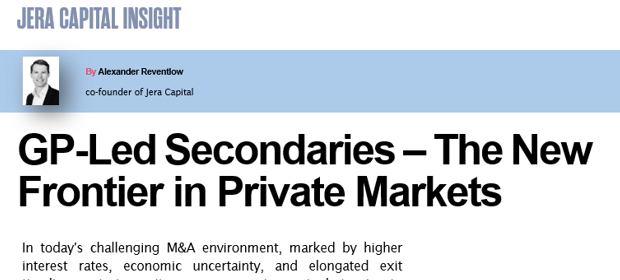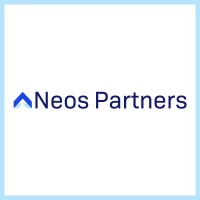
GP-led secondaries - The New Frontier
Private markets are evolving fast and GP-led secondaries are leading the charge. Our co-founder Alexander Reventlow has prepared a new memo to discuss hashtag#GPled transactions, see the key takeaways below:
✔️ GP-led transactions accounted to over USD 70bn in 2024
🥇 Allow to access high quality companies
🧩 Offer the opportunity to custom-build portfolios

In today’s challenging M&A environment, marked by higher interest rates, economic uncertainty, and elongated exit timelines, private equity managers are increasingly turning to GP-led secondary transactions as a dynamic and attractive exit and capital deployment strategy. Once considered a niche liquidity solution, GP-led secondaries have evolved into a strategic tool that not only extends the life of successful investments but also offers compelling opportunities for investors seeking exposure to de-risked assets with proven performance.
The Emergence and Evolution of GP-Led Secondaries
General Partner-led (GP-led) secondaries are transactions initiated by private equity sponsors (GPs) to create liquidity for existing investors (Limited Partners or LPs) or to manage assets more actively. These typically involve the transfer of one or more assets from an existing fund into a new vehicle a continuation fund backed by secondary capital.
Initially used as a means for LPs to exit legacy positions, GP-led secondaries have become a mainstream strategy. According to Jefferies' 2024 Global Secondary Market Review, the total secondary market volume in 2024 was $162 billion where GP-led transactions accounted for $75 billion, or 46%, of that total. More than half of these were single-asset continuation vehicles, highlighting a growing focus on concentrated, high-conviction investments.
Why GP-Led Secondaries Shine in a Difficult M&A Climate
The key attributes that make GP-led deals increasingly attractive in today’s private markets are:
- De-Risked, High-Quality Assets
Unlike traditional buyouts that involve newly acquired companies, GP-led secondaries revolve around assets that the GP knows intimately. These companies have already been operating under the GP's stewardship, with proven financial performance, seasoned management, and validated business models. This makes them significantly less risky than new investments.
- Control and Upside
GPs initiate these deals to retain control over high-performing assets that they believe have additional upside potential. Investors are offered the opportunity to deploy capital into assets with tangible track records and upside visibility, often underpinned by clear growth strategies, such as bolt-on acquisitions, geographic expansion, or digital transformation.
- Alignment of Interests
A hallmark of GP-led secondaries is the alignment between GPs and investors. GPs often roll significant carry and capital into the continuation vehicle, signalling strong belief in the asset’s prospects. New investors gain the comfort of investing alongside GPs who are financially and reputationally invested.
- Optionality for Existing LPs
In a climate where liquidity is at a premium, GP-led deals give existing LPs a valuable option: sell their stake and crystallize returns or roll into the new vehicle for further upside. This optionality enhances investor satisfaction and flexibility.
- Portfolio Management Efficiency
For GPs, these deals are a way to rebalance portfolios, free up capital, and concentrate on fewer, higher-performing assets. This makes GP-led secondaries a smart way to actively manage vintage funds without relying on suboptimal exits in tough markets.
Structural Flexibility Appeals to Investors
GP-led secondaries offer structural flexibility that appeals to a wide range of investors. One approach is the use of single-asset continuation vehicles, which are well-suited for high-conviction bets, often involving high-growth companies.
Another option is multi-asset vehicles, which provide diversified exposure across several companies, helping to mitigate idiosyncratic risk.
A third structure, tender offers, enables broader liquidity across a fund without requiring the transfer of assets to a new vehicle. Each format offers distinct advantages, allowing investors to align their strategies with specific risk-return profiles and liquidity needs.
Navigating Concerns and Mitigating Risks
While GP-led secondaries present attractive opportunities, they are not without challenges.
Valuation risk is a primary concern, as continuation vehicles may acquire assets at non-market prices—particularly when internal pricing lacks rigor and objectivity.
Another issue is the potential for conflicts of interest, since general partners are involved on both the buying and selling sides of the transaction. Without strong governance frameworks and independent fairness assessments, pricing and decision-making can become misaligned. Regulatory focus on these dynamics is also increasing, with a growing emphasis on transparency and investor protection.
Investor Due Diligence is Key
Investor due diligence is critical to managing the risks inherent in GP-led secondaries. To make informed decisions, investors must undertake comprehensive evaluations that go well beyond surface-level assessments. This includes conducting deep dives into the underlying assets, scrutinizing their historical performance, future exit scenarios, and the sponsor’s plans for value creation. Understanding how and where value will be generated over time is essential to assessing whether the continuation vehicle can deliver on its objectives.
Investor due diligence is critical to managing the risks inherent in GP-led secondaries. To make informed decisions, investors must undertake comprehensive evaluations that go well beyond surface-level assessments. This includes conducting deep dives into the underlying assets, scrutinizing their historical performance, future exit scenarios, and the sponsor’s plans for value creation. Understanding how and where value will be generated over time is essential to assessing whether the continuation vehicle can deliver on its objectives.
Equally important is a thorough analysis of the transaction’s structure—specifically the terms, governance arrangements, and mechanisms in place to align interests between the general partner and investors.
In addition, attention must be paid to both fund-level and deal-level economics. This involves understanding how fees, carried interest, and other economic incentives are structured, and whether they create appropriate alignment between all parties involved. A transparent and well-balanced economic framework can significantly reduce the risk of conflicts and misaligned incentives, helping investors participate with greater confidence.
Outlook: A Growing Role in Private Markets
The outlook for GP-led secondaries remains bullish. With M&A markets continuing to show limited activity, more general partners are expected to turn to continuation funds as a means to extend hold periods and unlock additional value. At the same time, limited partners and secondary buyers are increasingly appreciating the compelling risk-adjusted returns and enhanced transparency these transactions can offer.
The outlook for GP-led secondaries remains bullish. With M&A markets continuing to show limited activity, more general partners are expected to turn to continuation funds as a means to extend hold periods and unlock additional value. At the same time, limited partners and secondary buyers are increasingly appreciating the compelling risk-adjusted returns and enhanced transparency these transactions can offer.
Several emerging trends are poised to shape the market's evolution. One is the institutionalization of deal flow, marked by growing standardization and increased scale. Another is the integration of technology, particularly the use of AI and data analytics to improve the efficiency and accuracy of due diligence. Lastly, the market is witnessing a rise in retail participation, driven by the democratization of access through feeder funds and digital investment platforms.
Conclusion: An Efficient Capital Deployment Tool
In a private equity market grappling with exit bottlenecks and valuation uncertainty, GP-led secondaries offer a pragmatic and performance-oriented solution. They enable capital deployment into de-risked assets with real growth potential, offer enhanced alignment and transparency, and help both GPs and LPs navigate a complex landscape.
Investors willing to embrace this evolving strategy stand to benefit from attractive entry points, stable governance structures, and meaningful upside potential—making GP-led secondaries a compelling choice in the current market environment.
2
LikeDiscussion
Share
Discussion
You are commenting on GP-led secondaries - The New Frontier
You must be logged in to add a comment
There are no comments
Be the first to add to the discussion
Fund manager

Jera Capital
Copenhagen K, DenmarkJera Capital builds select exposure to unlisted companies through secondary transactions alongside leading private equity managers in North America and Western Europe. Our focus is to acquire interests in well-established companies with strong value creation potential and a sustainable agenda
private equitysecondary
Related news


Lonsec Endorses Coller Capital as a Trusted Leader in Private Equity Secondaries

Capital Dynamics Closes Secondaries Fund Above Hard Cap

Coller Capital Acquires $1.6bn Senior Direct Lending Portfolio in Landmark LP-led Credit Secondaries Transaction

Partners Capital Investment Group Announces Minority Investment from General Atlantic


Carlyle and UBS’s Unified Global Alternatives business collaborate on Private Equity Secondaries Initiative

Neos Partners Raises $1.37 Billion Fund II to Invest in the Energy Transition and Critical Infrastructure Sectors

Antares Closes $1.2 Billion Private Credit Continuation Vehicle Led by Ares Management
